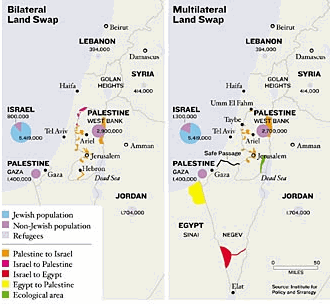Solving the Israel-Palestine Standoff
Charles Krauthammer is uncharacteristically enthusiastic about the advances in Israeli security made in recent months.
Because we Americans tend to gauge Middle East success by White House signing ceremonies complete with dignitaries, three-way handshakes and pages of treaty provisions, no one seems to have noticed how, in the absence of any of that, there has been amazing recent progress in defusing the Arab-Israeli dispute.
[…]
The other great watershed has been the maturation of the Palestinian national movement. Arafat was a revolutionary who disdained nation-building. Revolutionaries destroy the old order. His mission was to destroy Israel. Which is why, to the consternation of his Western admirers, in 10 years he built not a single schoolhouse, hospital or road in the territory he controlled. Instead, he built a dozen private militias and a state propaganda machine designed to poison the new generation against Israel. Now that he is gone, the Palestinian cause can begin the demystification from revolution to nation-building.
The other demystification was Gaza. The Gaza Palestinians have just received exactly what they wished for: self-government, borders, openings to the outside world and a complete absence of any Jews. As a result, however, they are now faced with the distinctly unromantic task of creating their new state. It’s not that many Gazans would not like to continue the romance of revolutionary terror and jihad. But they no longer have the means. The separation fence makes it almost impossible to launch attacks into Israel. And rockets launched into Israeli towns are met by retaliatory Israeli artillery barrages that make the rocketeers rather unpopular at home. A similar equilibrium will be achieved on the West Bank when the fence is completed next year.
He recommends Uzi Arad’s piece, “How land swaps could settle the Israeli-Palestinian conflict” in The New Republic. It argues that a permanent peace between these long-warring groups can be had by continuing down this path and creating two nation-states.
The necessity–in fact, the inevitability–of partition has drawn its strength from the observable fact that both the Jewish and the Palestinian societies are bent on exercising as well as advancing their distinct identities to the point of national self-determination. Embedded in the partition concept, therefore, is the cultural and ethnic divide between the two peoples. By now, even most Palestinians–who, in previous decades, rejected a two-state solution–have recently come to accept the formula.
He provides two maps, along with substantial explanations, of two proposed configurations that he believes could gain widespread support:

Arad notes that a strong consensus exists in both Israel and Palestine for a settlement along those lines and there is strong American backing as well:
Land swaps have become an imperative element in almost every final status proposal. In December 2000, for example, President Bill Clinton set forth what is widely considered the most authoritative set of principles for a future bilateral partition between Israel and Palestine. He said that the Palestinian state should include somewhere between 94 and 96 percent of the West Bank, with a land swap of 1 to 3 percent and other territorial arrangements to compensate for the land Israel would annex for its settlement blocs. Clinton also said that any deal should allow Israel to annex 80 percent of Jewish West Bank settlers in blocs, preserve territorial contiguity for both sides, and minimize the number of affected Palestinians.
This vision, with minor changes, has been embraced by the Bush team as well.
A more radical plan exists as well:
In addition to the bilateral land-swap plans, another plan calls for multilateral land swaps between Israel, the Palestinians, and Egypt. Hebrew University’s former rector, the geographer Yehoshua Ben-Arieh, has proposed that Israel transfer to Egypt some 200 to 500 square kilometers in the Negev contiguous to the Sinai Peninsula, along with a corridor across the Negev, creating a land bridge between Egypt and Jordan. In return, Egypt would transfer to the Palestinians an area twice the size of the northern Sinai, contiguous to the Gaza strip, significantly increasing the territory of one of the most densely populated areas in the world. In turn, the Palestinians would agree to Israeli sovereignty over areas in the West Bank of commensurate magnitude. The latter would include not only the contiguous Jerusalem neighborhoods and settlement blocs, but also additional territory with no Palestinian inhabitants along the Jordan River, on nature reserves in the Judean desert, and on the Dead Sea shore.
The primary advantage of this wider land-swap deal is that it would enhance the economic and social viability of the Gaza Strip and allow Israel to keep a greater portion of the West Bank. Palestinians and Israelis would benefit significantly from such an exchange. Senior American, European, and Middle Eastern officials have all expressed interest in the idea, though Egypt has indicated that it is not yet ready to consider this proposal. A final settlement of the Arab-Israeli dispute still requires much work and will take some time. By then, hopefully, Egypt will embrace such flexibility, which would greatly benefit the Palestinians and further its own quest for regional power.
This may be a hard sell politically but I’ve long thought something along those lines (indeed, including cession of land by Syria, Lebanon, and Jordan, too) would be the best solution. The Palestinian population is huge, and they need the land mass. Their neighbors would benefit, too, from the emigration of the large Palestinian diaspora in their countries.






The problem with all these suggestions is that it pre- supposes goodwill on both sides. I would like someone to tell me what the Oslo accords has achieved for Israel. Everything the Israelis have achieved has been the result of them doing something with no reciprocation from Palestine.
As an American visiting Israel at this very moment on business, I have to say that this analysis matches what I am hearing from the Jewish side. Specifically: people here are optimisitic about the future, they think a deal will be worked out, and they think both sides will go along with hard, but reasonable, concessions.
And the big change that is making the Jewish side optimistic about a deal: the death of Arafat.
But my personal conversations are not the only clue. New polls being released here as the result of the new political party show the same thing.